Travelling during the holiday season is one of my favourite things to do. Taking part in different countries’ holiday events and festivities is an excellent opportunity to learn more about the place you’re visiting and dive into the different ways people worldwide celebrate Christmas. But the holidays are busy and many people want to stay close to home with family But if you’re looking to find a way to bring the joys of travelling home for the holidays this guide is here to help! There is nothing as extravagant and joyful as the Palace of Versailles at the holidays.
I remember so well those glimmering hallways, golden decorations and sprawling crystal chandeliers which seem to bloom off the ceiling. Although I never visited during the holidays, I wanted to discover for myself how what Christmas at Versailles would have been like for the court and of course for Marie Antoinette herself!
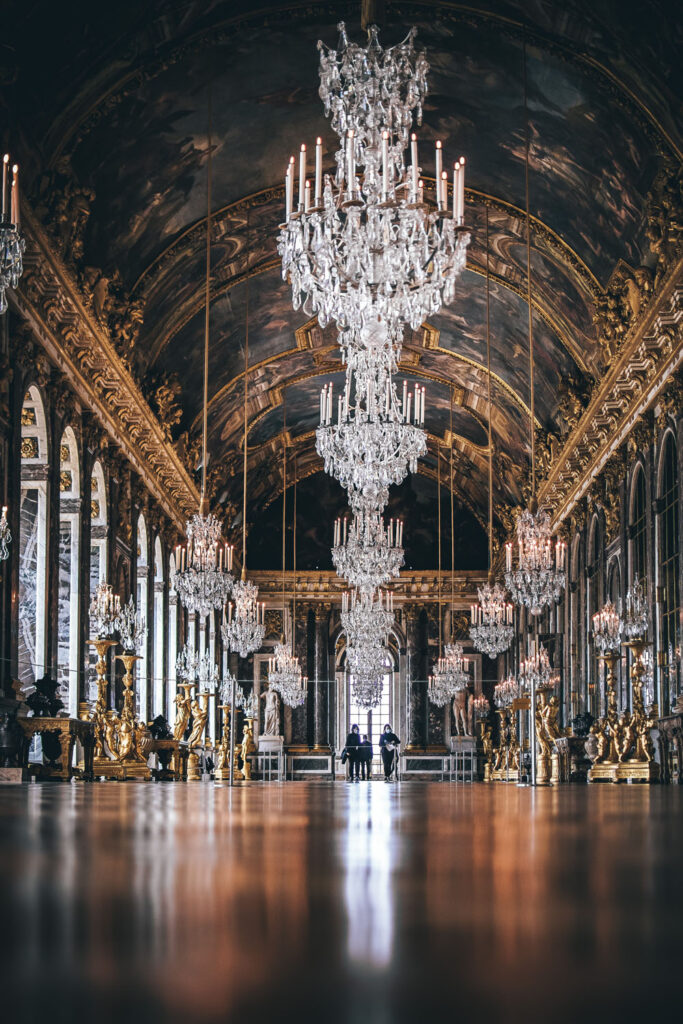
There is so much you can do even from inside your home to give yourself the sense of travel through new experiences and discoveries. From my own travels and research, I have created this series of posts about bringing the holidays from around the world to your home this Christmas! So let’s dive into our next at-home adventure, by exploring the world of the crème de la crème of party hosts; Marie Antoinette and Christmas at Versaille.
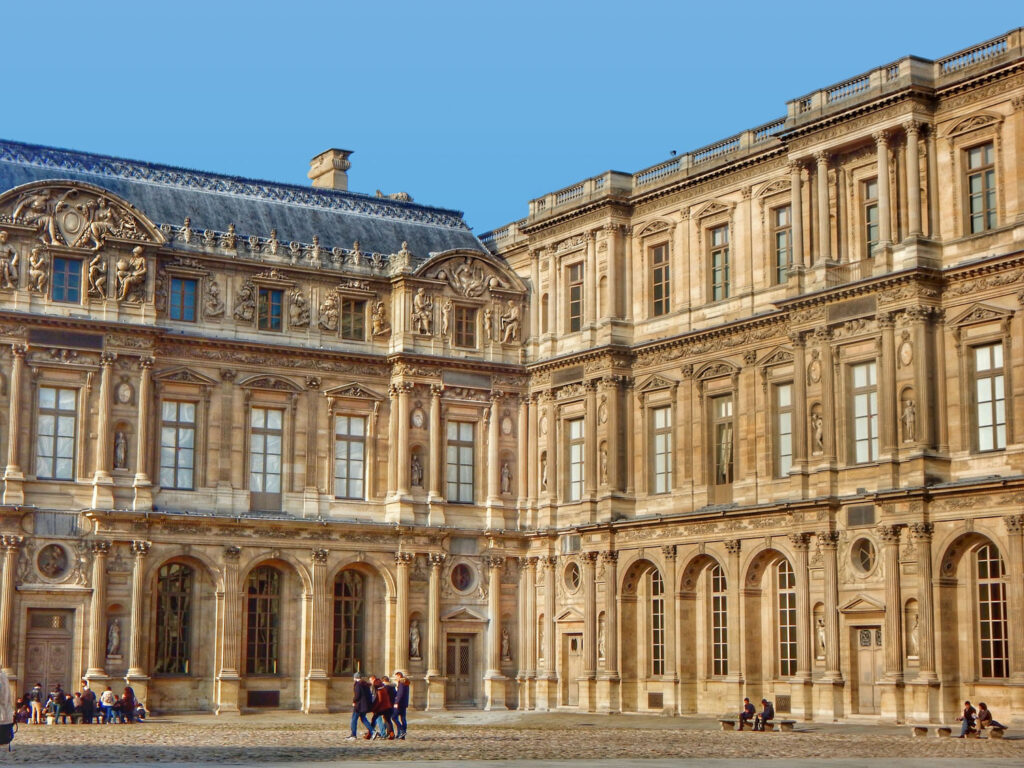
History of Versaille
Versailles was built in 1623 for Louis XIV. He had initially conceived of the palace as a hunting retreat outside the city of Paris. But when Louis XVI moved in with his wife Maire Antoinette, they transformed the relatively plain, old palace into a spectacle of grandeur unlike anyone had ever seen before. While their reign ended in bloodshed, the time they at Versailles would be legendary. As were the parties and festivities they hosted while they lived inside these great golden walls.
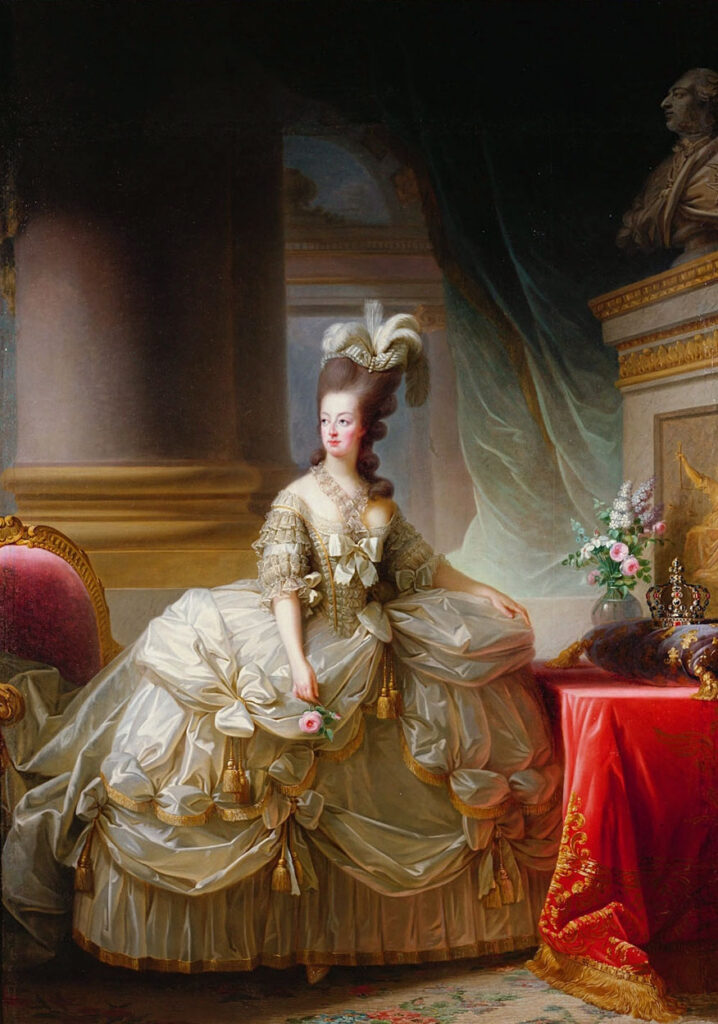
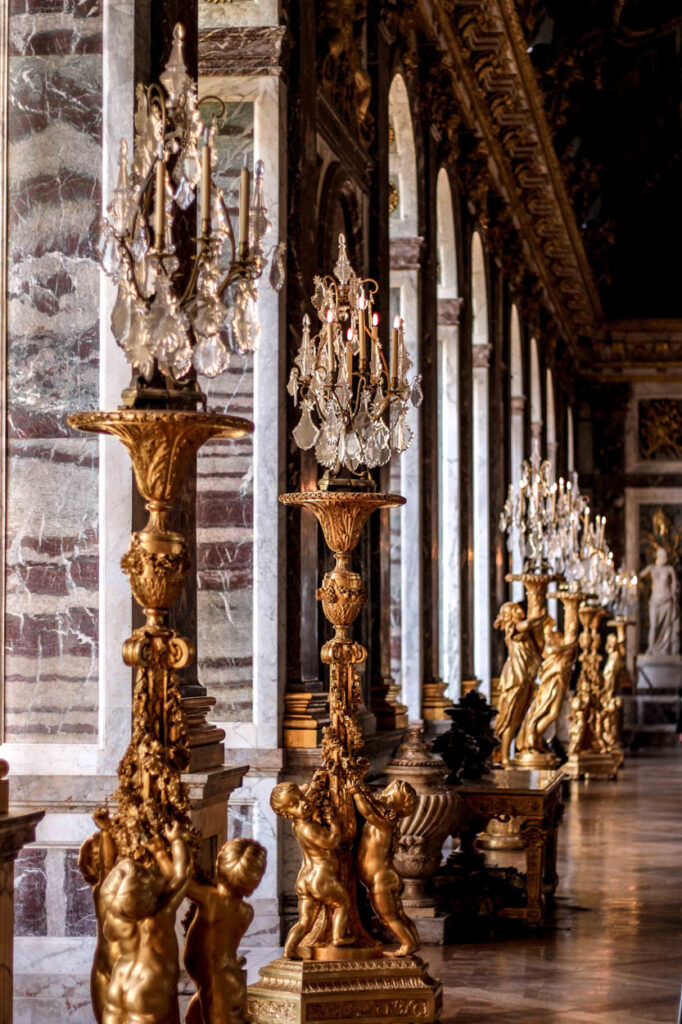
Decorate your own French Baroque Christmas Tree
Versailles saw its first Christmas tree in 1738. Queen Marie Leszczyńska, wife of Louis XV, had a tree brought into the palace as it was one of the Queen’s most beloved traditions from her home in Austria. This was long before most of the French population had even heard of a Christmas tree. This Germanic tradition wouldn’t be popular throughout all of France until 1837 when the first public French Christmas tree was installed inside the gardens of the Tuileries in Paris. It was such a lovely thing that all the fashionable ladies of France adopted the tradition immediately.
Incorporating all the fashionable trends from Versailles makes creating your own Versailles Christmas tree super simple! If you have a huge ornament stash like me it just takes a little bit of curation to pick out the ornaments which will suit a French baroque style.
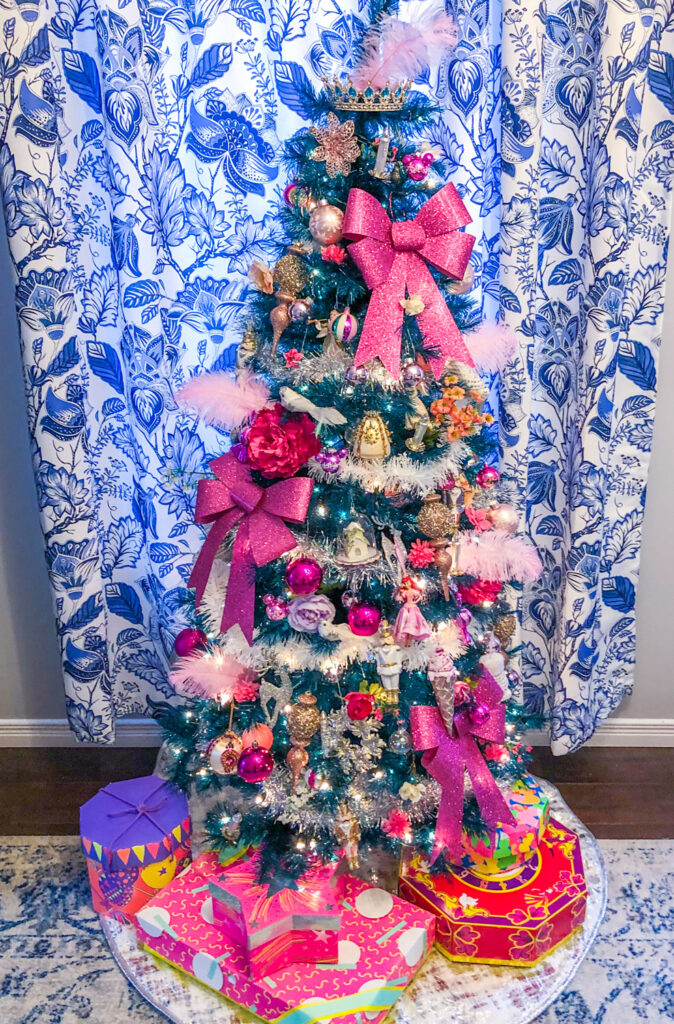
This is what you’ll need to create your Versailles inspired Christmas Tree:
- Stick with pastels ornaments (my tree was almost pale blue, so I went with all white, pink and silver ornaments)
- Oversized bows really make the tree look like a giant courtiers’ dress!
- Pink ostrich feathers fill out the tree and give it some dimension
- Food-themed ornaments. The famous quote “let them eat cake!” is synonymous with Versailles and Marie Antoinette. Find ornaments in the shape of sweet treats to help the tree feel like a table at Versailles (Macarons are the best)
- Mirrored ornaments emulate the look of the ‘Hall of Mirrors’ in Versailles and give the tree some real sparkle and shine!
- Stick with white lights as they compliment the pastel theme the best.
- A crown used a a tree topper instead of a star is the icing on the cake!
The more opulent and overstuff your tree is the better it will look. And there you have it, your very own Versailles in the living room! A tree fit for a Queen!
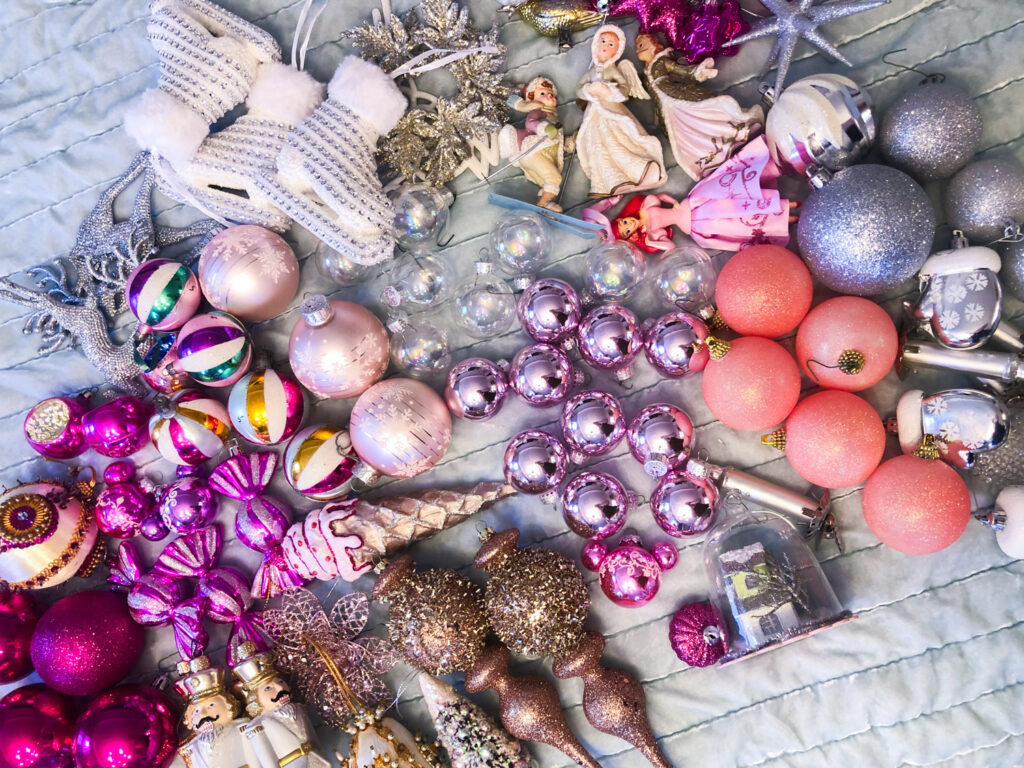
Drink Hot Chocolate
During the 18th century, chocolate was considered a great luxury and reserved only for the upper classes. Anne of Austria first brought chocolate to France in 1615. It was originally a wedding gift for her 14-year-old betrothed, King Louis XIII. But it was Marie Antoinette and King Louis XVI who really indulged in the treat. Hot Chocolate was known to have fortifying, aphrodisiac and energizing virtues. It was akin to drinking the ambrosia of the gods.
King Louis XV loved the drink so much he was known to prepare his own hot chocolate inside his private apartments. His lover, Madame Du Barry, was also fond of the exotic beverage. No doubt they would share in the drink before heading off for a secret rendezvous!
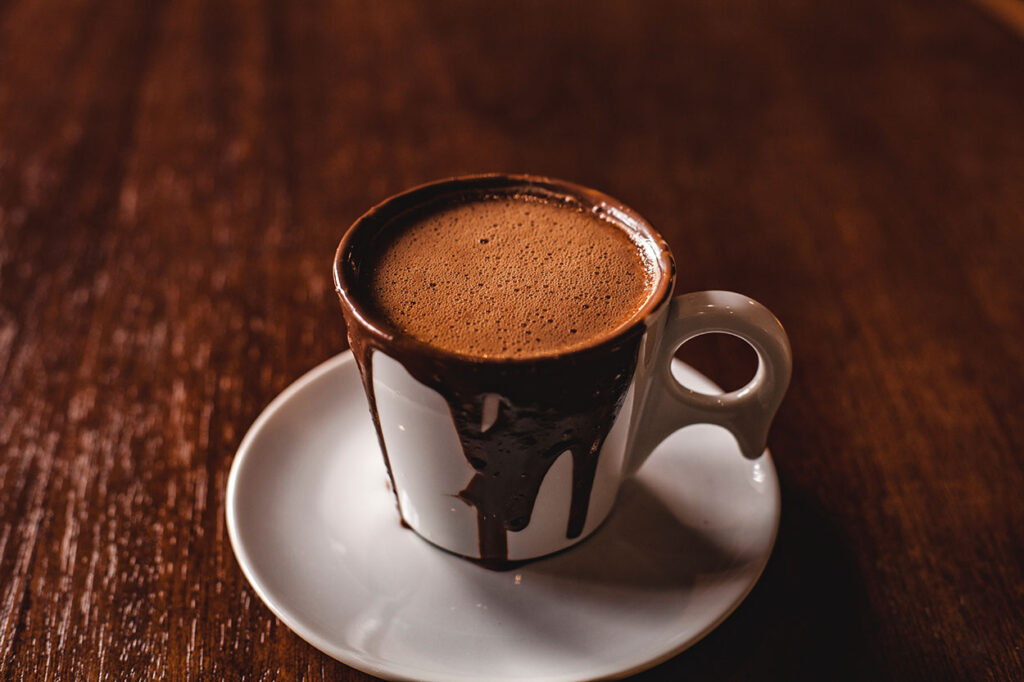
Marie Antoinette had her private chocolate-maker brought to court with her. They carried the title “Chocolate Maker to the Queen.” This person was responsible for inventing new flavour combinations of chocolate and ensuring the queen always had enough on hand to serve out to her many guests. This chocolatier is famous for creating the first orange blossom hot chocolate, which became a court favourite.
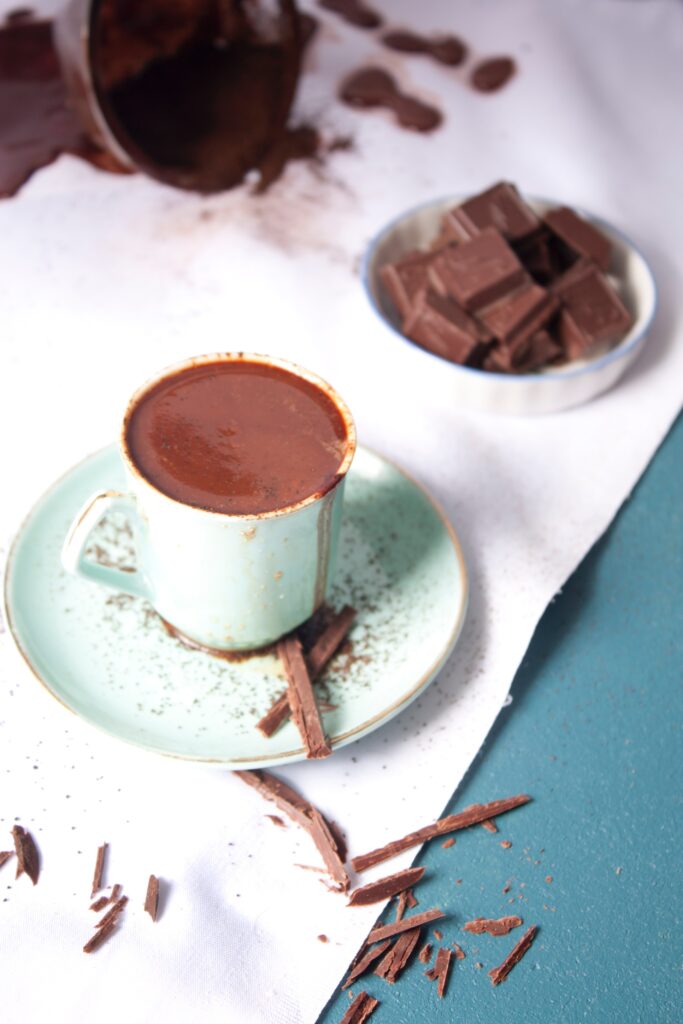
Make Your Own Royal Hot Chocolate
Indulging in your own hot chocolate at Christmas time is one of the easier things to do at home. While instant hot chocolate mix might do the trick, Marie would disapprove. Luckily for us, Louis XV’s recipe has survived the centuries!
“Place an equal number of bars of chocolate and cups of water in a pot and boil on a low heat for a short while. When you are ready to serve, add one egg yolk for four cups and stir over low heat without allowing to boil. It is better if prepared a day in advance. Those who drink it every day should leave a small amount as a flavouring for those who prepare it the next day. Instead of egg yolk, one can add a beaten egg white after removing the top layer of foam. Mix in a small amount of chocolate from the pot and finish with the egg yolk.”
Dinners of the Court or the Art of working with all sorts of foods for serving the best tables following the four seasons, by Menon, 1755
The recipe is rather odd to be sure. A more modern adaptation of the recipe omits the egg but adds in the orange blossom. If you prefer to buy a ready to make version this drinking chocolate is a universal favourite.
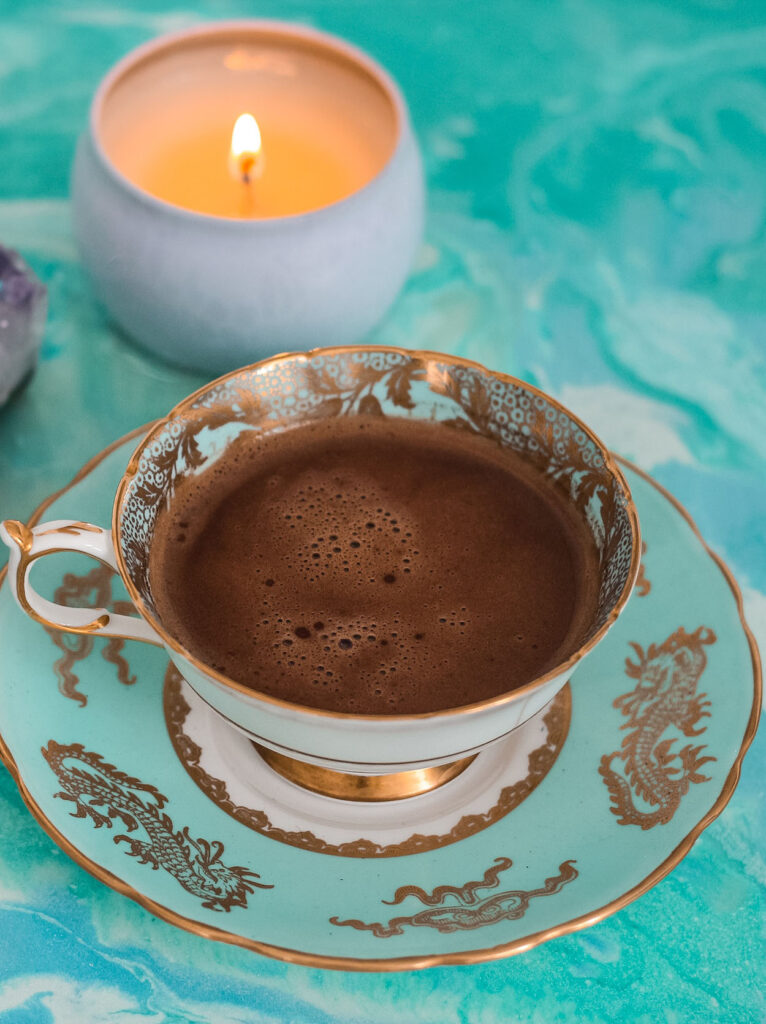
Shoes by the Fireplace
In France, instead of Santa Claus, they have Père Noël, or “Father Christmas“. Unlike the North American traditions of leaving stocking hung by the fireplace, French children would place their shoes in front of the fire. Then they would fill them with carrots and treats. French children left these treats for Père Noël and his donkey, Gui. The shoes would then be filled with small gifts like candy, money or little toys. If you’re looking to change up your holiday traditions or don’t have a fireplace mantle upon which to hang your stockings, this is a fun alternative! Marie Antoinette famously had hundreds of very posh pairs of shoes. I love to imagine all the fireplaces in Versailles decked out with those precious shoes by the fire the night before Christmas.
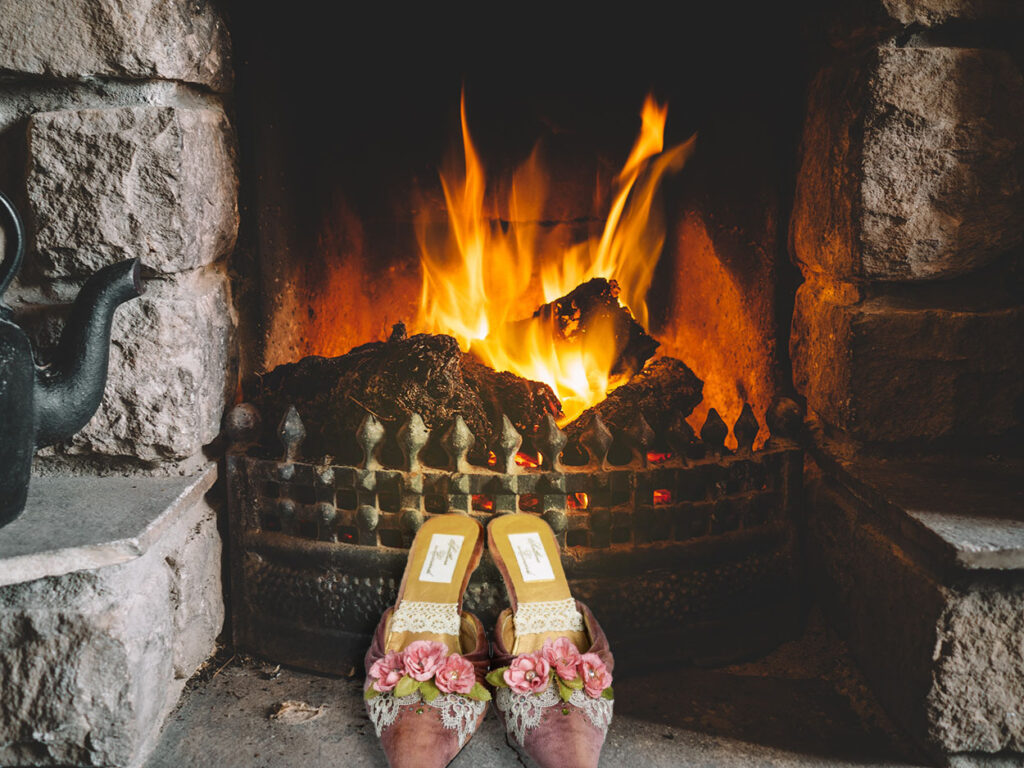
Listen to a Midnight Mass Opera
In the diaries of Saint-Simone, King Louis’s courtier, he details the extravagant ways in which the king would prepare Versailles for Christmas. In the Royal Chapel inside Versaille, my favourite places in the palace, he would hold three-midnight masses on Christmas eve. They were all held under cover of darkness, lit only by candlelight. The opera’s music would resonate loudly against the opulent decorations glimmering in the candlelight.
Many recordings of modern concerts inside Versaille’s baroque church have been recorded. Throw them up on your TV, light some candles and grab a glass of wine to relax and enjoy the magic.
Take a Decadent Bath
Christmas time can be stressful, and there is nothing like a good soak in the bath to relieve all your tension and just relax. Marie Antoinette loved to indulge in her bathtime rituals. Despite bathing being very uncommon at the time and seen as very wasteful, she never missed an opportunity for a bath. Marie would take her baths in the morning with a tray of breakfast pastries. So order in some of your favourite baked goods to eat while you relax.
Marie would add perfumes (or essentials oil) into the water along with herbs like thyme, marjoram and Epsom salts. Often she would throw in fresh flowers to amp up the fragrance. A famous perfumer recorded one of the bath sachets he made for the queen. It included; sweet almonds, pine nuts, marshmallow root and lily bulb. Take some inspiration from these scents to create your own Christmas soak.
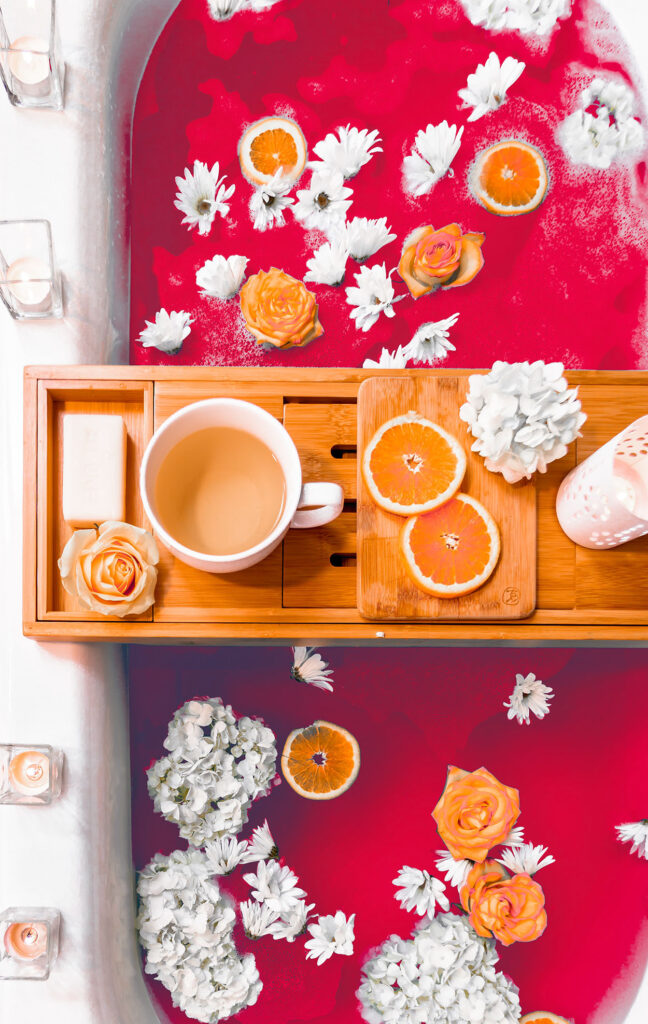
Go for a Skating Outting
Skating on frozen lakes became popular in Europe in the 17th century. It was a new means of entertainment for people during the long, cold and rather boring winter months. Marie-Antoinette herself was known to skate and enjoyed large skating parties in the gardens of Versaille. Marie Antoinette was a recognized master of sliding by Chevalier de Saint-Georges, who was her partner on the ice. Take a note from the great Marie and head out to your local skating rink with some friends. It’s a great way to enjoy the wintertime festively while still keeping a safe distance. Remember, dressing for the colder months doesn’t have to be a chore. There are so many ways to accessorize your wardrobe just as Marie would have and make dressing for warmth fashionable.
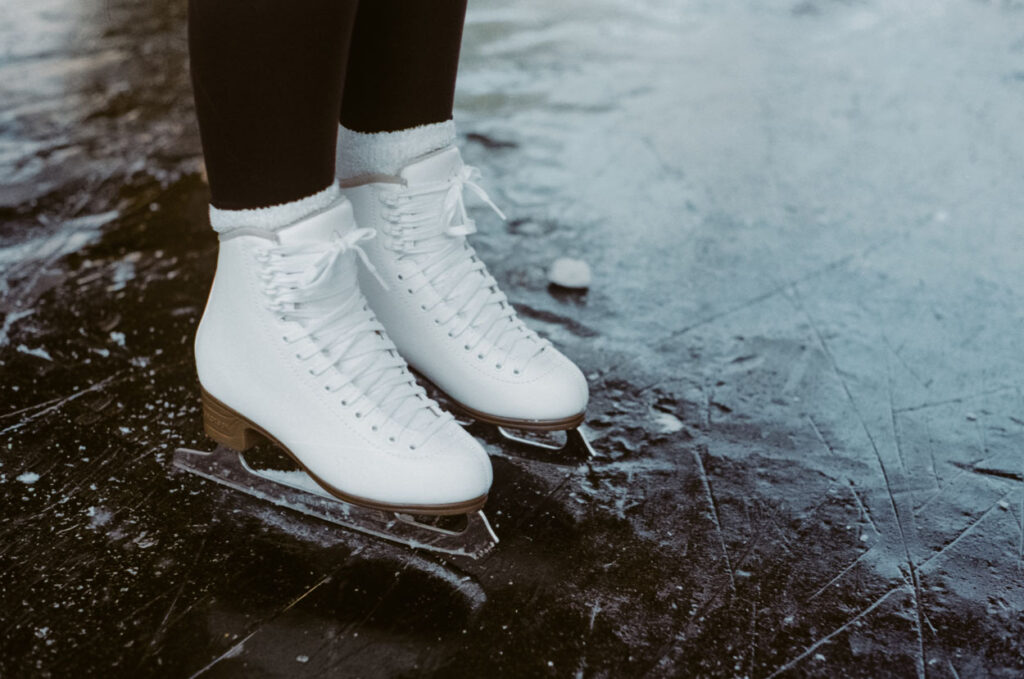
Fill the House with Flowers
Marie Antoinette loved flowers. It was one of her greatest joys to tend to her little garden in Versailles, the Petit Trianon. Not only did she love the smell, but she also had an infinity for their appearance, decorating the wallpaper and upholstery is her palace with floral motifs.
Filling your house with flowers during the holiday season is a great way to bring easy splendour into the home. It’s incredible how a few sprays of flowers can make your house feel warm and inviting. When we think of holiday flowers, the amaryllis always comes to mind. Hypericum berries are another popular winter plants, and these will keep their colour and shape all month long as they don’t wilt like flowers.
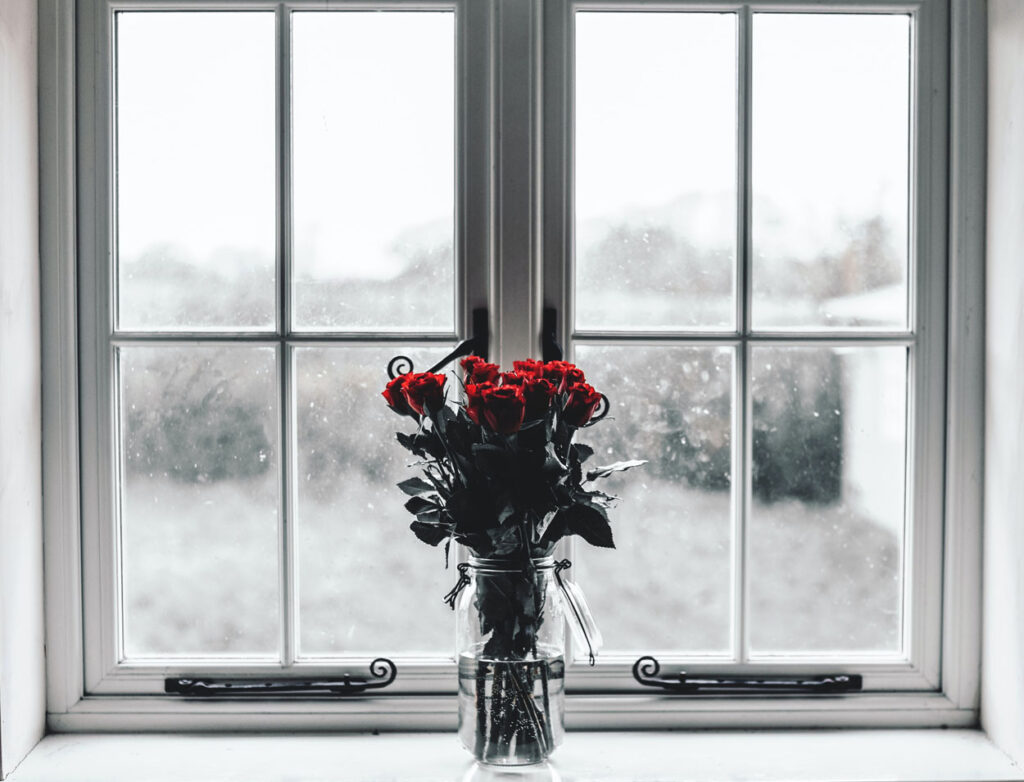
Christmas Carnations
Carnations have got a bad reputation as an unloved flower, but I implore you to change your mind about them! They bloom and thrive in the winter, come in a myriad of colours and last a long time! Roses are another year-round flower which is always available and one of Marie’s favourites. Finish your bouquet with some balsam or fir trimming, and you will have a floral design that will light up the room and smell amazing!
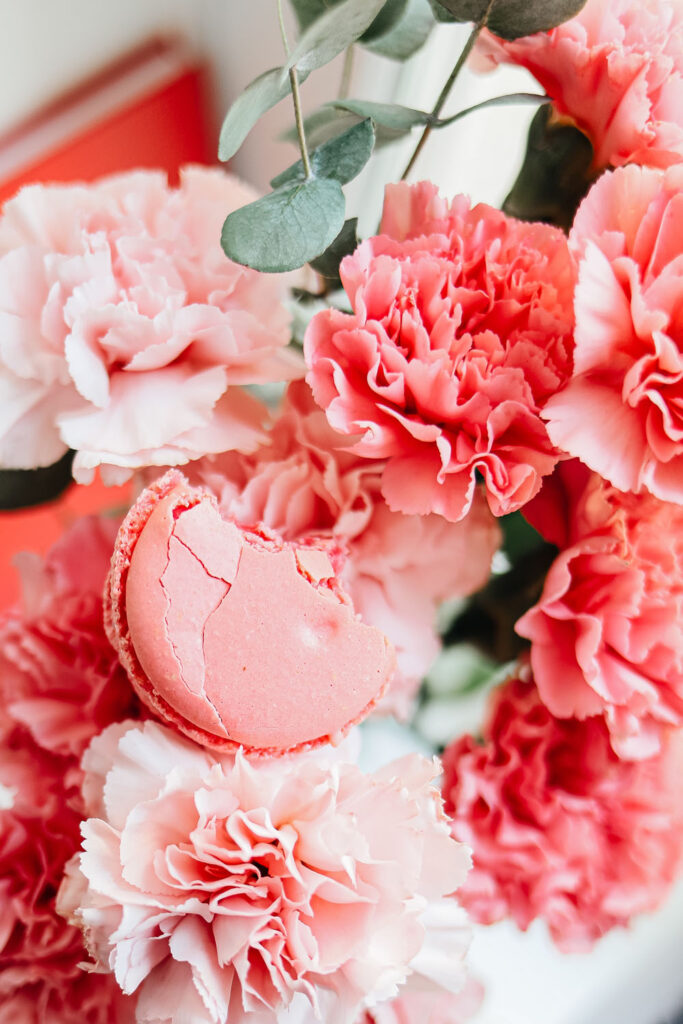
Bake a Bûche de Noël
Having a Bûche de Noël is a Christmas staple in France. A traditional Bûche de Noël is a light sponge cake, rolled into the shape of a log and garnished with either chocolate, mocha or chestnut filling. These desserts would have been something important for the Royals to have at their Christmas dinner. The Bûche de Noël has been a tradition that dates back to medieval times, long before Marie was queen. In medieval France, during paganism, a large log from a fruit tree was burnt in the family hearth and sprinkled with wine to ensure a successful harvest the following year. Some people would also sprinkle salt or holy water on the fire to ensure good fortune befell them.
Once lit, the log must burn for three days to ensure you have good luck. When wood-burning hearths began to disappear inside the home, replaced by stoves, logs were left on the counter as a symbolic reminder of this old tradition. One day, a baker came up with the idea to turn the log into a dessert and a new tradition was born. Because it’s much nicer to eat the log rather than just stare at it. There are plenty of bakeries that serve this dessert all over the world but if you’d like to try your hand at baking your own, they are a joy to decorate as you please!
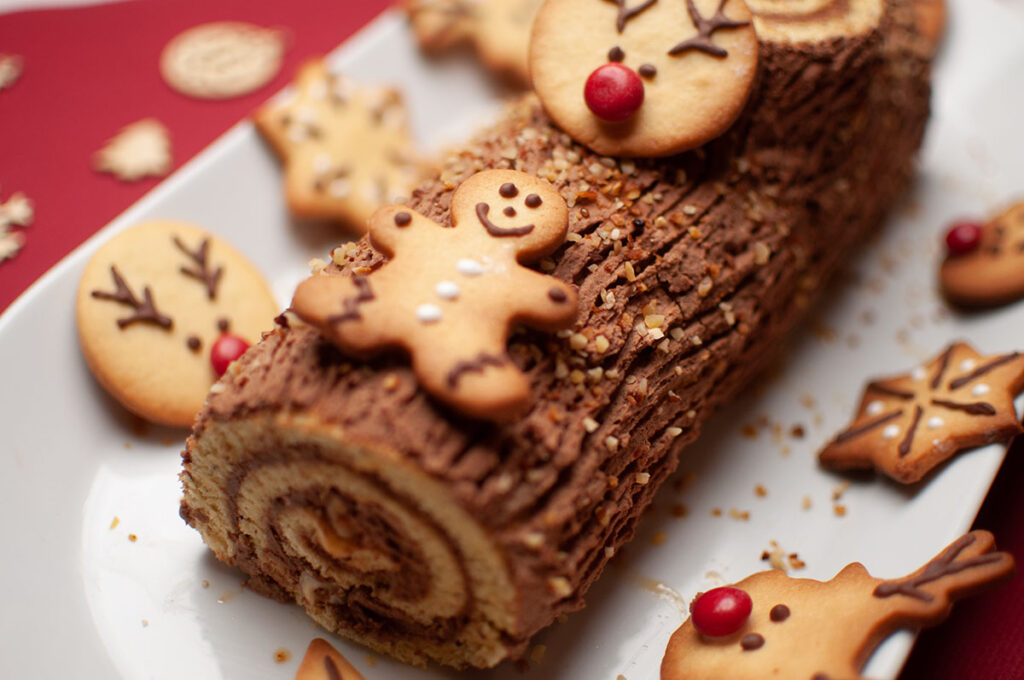
Give Loved Ones Les Papillotes
One of the most popular chocolates in supermarkets in France during Christmastime is called Les Papillotes. This chocolate is wrapped in brightly coloured papers and hidden inside, is a little message. Chocolatier Monsieur Papollot invented this chocolate in Lyon in the late 17th century as means of sneaking love notes to his beloved. While Americans have fortune cookies, these little notes inside are always related to love.
The trend of serving Les Papillotes after dinner as a game for your guests eventually made its way to the court of Marie Antoinette. Versaille’s Christmas tables would have been replete with these shiny chocolates, as Versailles was a hotbed of illicit love affairs. If you can’t find Les Papillotes in your supermarket, you can pick up some wrapped chocolate and write your own love messages to put inside.
Here are some examples from historic Papillotes:
The day that is the most wasted is the one when nobody has laughed.
It isn’t enough to have talent. You need to know how to use it.
Out of all the passions, the only respectable one seems to me to be the love of good food.
Life is like a story; what matters is not its length but its worth.
Love, love, when you have a hold over us, it can be said: goodbye to being careful.
He who asks a question risks looking ignorant for five minutes. He who asks no questions will remain innocent for all of his life.
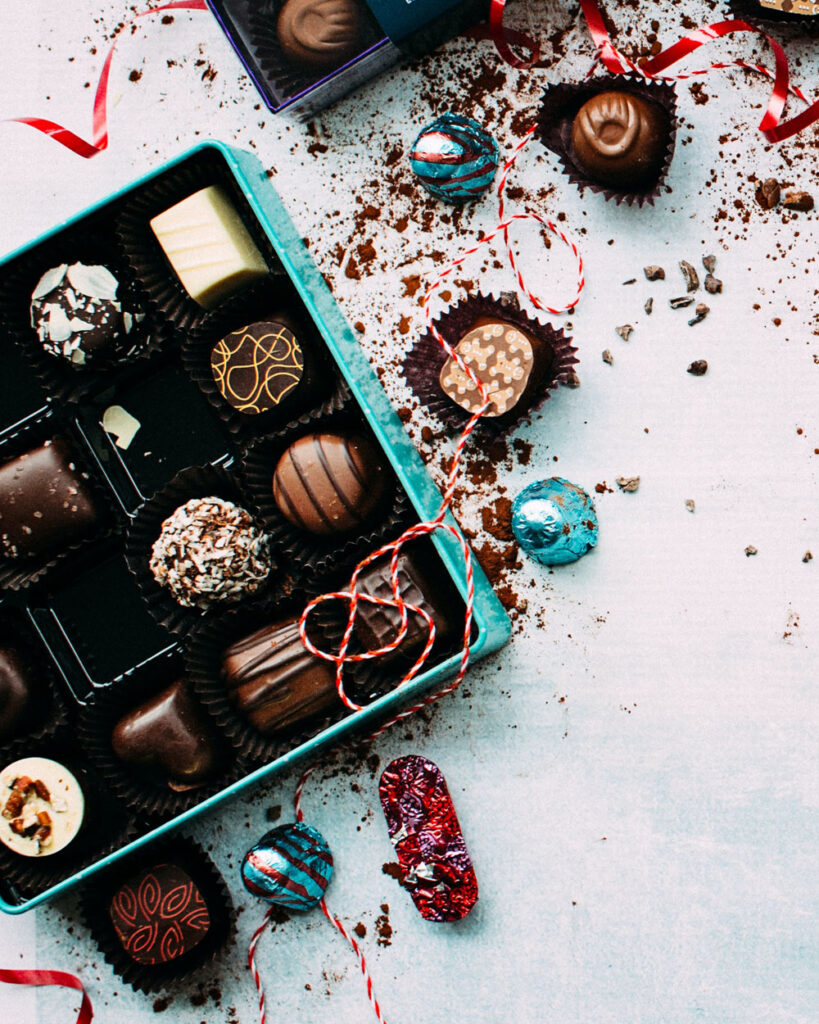
Hang Mistletoe for Luck
Unlike other parts of the world where Mistletoe is seen as romantic, the French surprisingly don’t share in that same traditions A shock for a nation of people who are almost always associated with love and romance. But that doesn’t mean the French don’t’ still love Mistletoe! They still swag it all over their palaces, but for the French, Mistletoe is hung above doorways as a sign of good luck for the year to come! Perhaps Marie and Louis should have hung far more inside Versaille. Maybe that would have been the luck they needed to avoid their eventual demise…
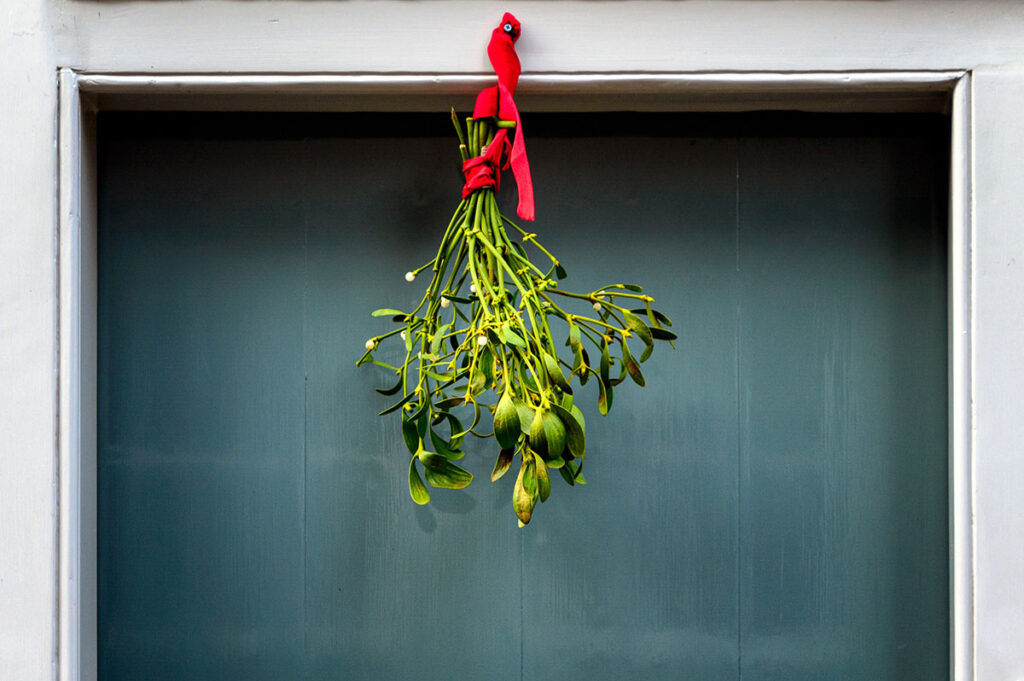
Try Making Marron Glacé
One of King Louis’s favourite Christmas treats was Marron glacé, or candied chestnuts. The great chef François Pierre La Varenne created the candy for King Louis XVI who loved chestnuts. Luckily for us the recipe for the king was preserved in Varenne’s original cookbook dating back to the 16th century. These would have been a favourite treat for Versaille’s court, and they are still sold in France during the holiday season. If you can’t find them in the store, they are pretty easy to make at home. All you need is fresh shelled chestnuts, sugar and vanilla!
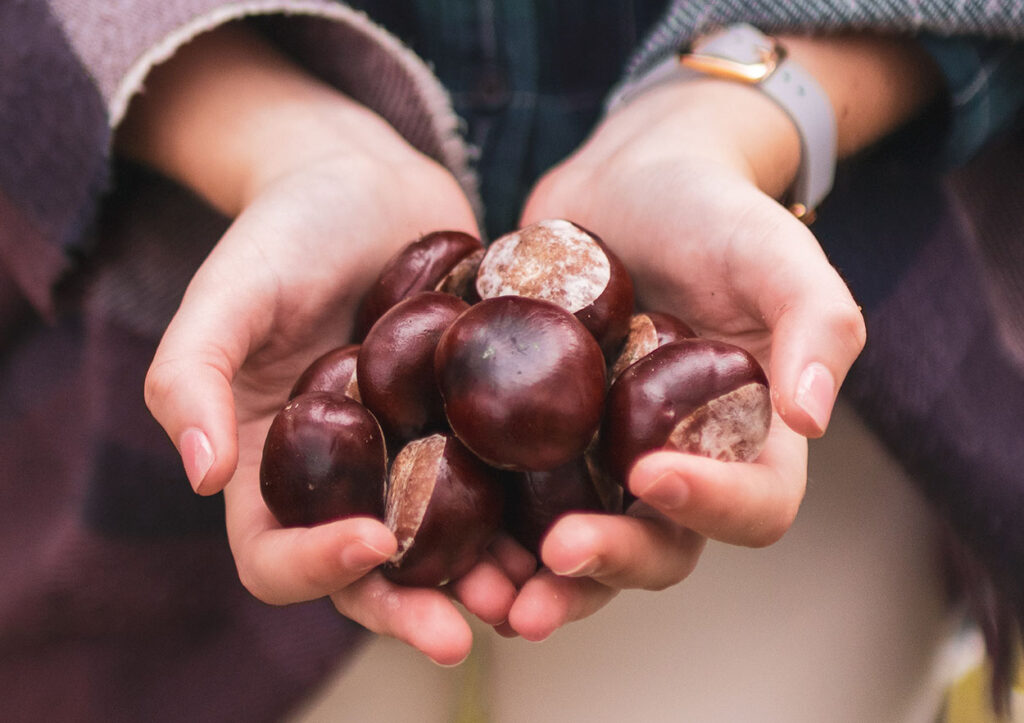
Sip on Sparkling Wine
To end your evening, indulge in a spirit that once flowed like water in the halls of Versaille; Sparkling Wine. France’s Sun King, Louis XIV, was obsessed with Dom Perignon. And back then, Dom Perignon wasn’t a brand but an actual man! Dom Perignon owned a great winery but some of the bottles he was producing kept being tainted with bubbles. Back then, bubbles were seen as a flaw in the product and something to be eliminated. As they discovered they couldn’t succeed in getting rid of all the bubbles, they decided instead to embrace them. They found a way to INCREASE the bubble inside the bottle by being the first to invent the wine cork.
They also invented a device used to press the grapes more gently to create a less murky and more clear wine. When he tasted the improved product for the first time, Perignon exclaimed, “Come quickly, I am tasting the stars!” Louis XIV drank champagne almost exclusively, and it was the drink of choice for the court all year round!
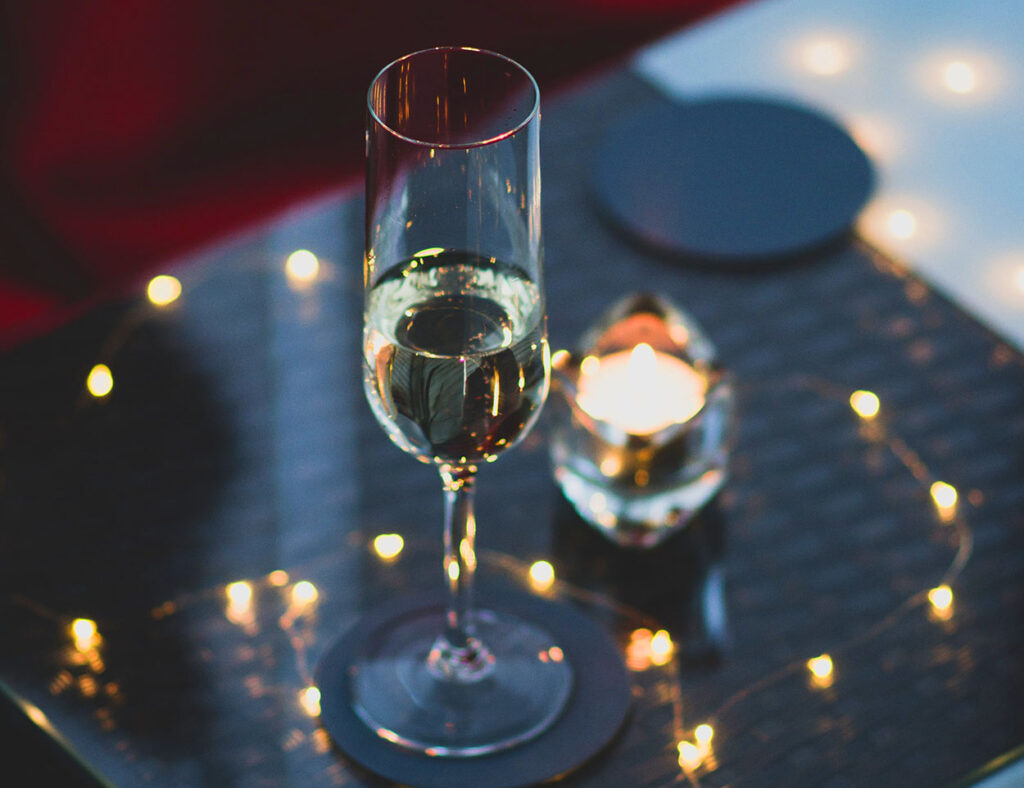
Sitting around a Fireplace
Versaille’s was a summer palace and anyone still there in the winter suffered greatly. They had a massive heating problem. In 1709 a great winter storm blew through France, and the temperatures inside Versailles registered at below 20 degrees! It was so cold wine would freeze to ice in your glass. It was so expensive to heat all 1,300 fireplaces inside the palace. But even with all these fireplaces, the windows and doors’ poor insulations meant keeping the heat inside the palace was almost impossible. Any guests in the Versailles at Christmas time would all cozy together around the fire for warmth. If you have a fireplace, indulge in it this year, even if it’s just a gas one or even a little imitation fireplace. Even in a condo, you can have a cozy little private quarter.
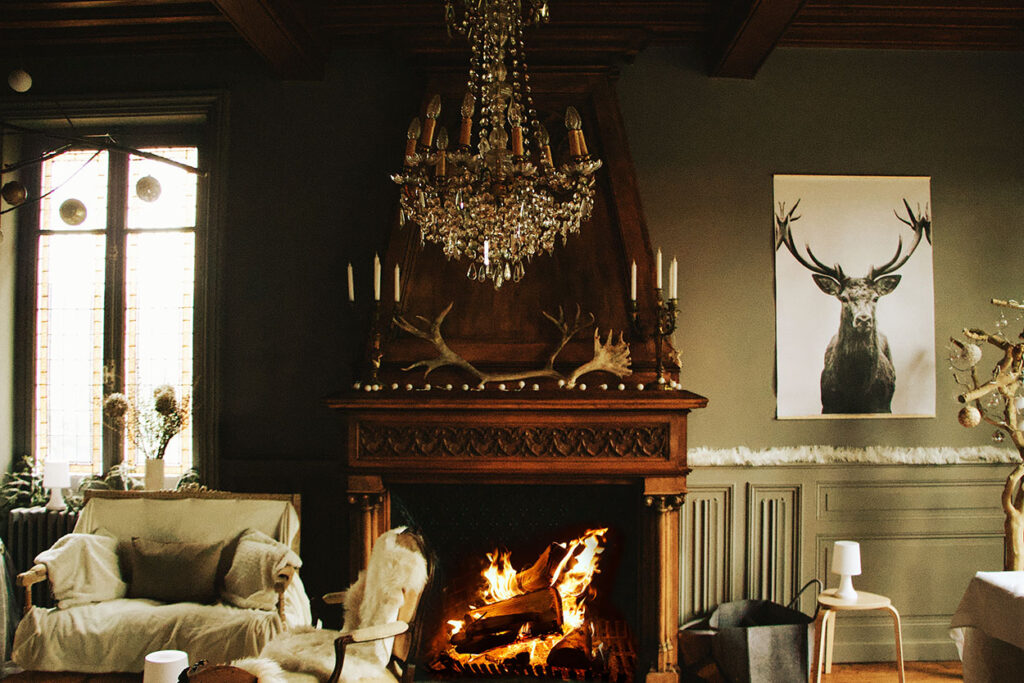
To Macarons or not to Macaron?
Despite their prevalence in the 2006 movie Marie Antoinette by Sophia Coppola, macarons were NOT a pastry that would have been eaten in Versailles or by Queen Marie Antoinette. Although the macaron dates back to 1533, that version of the macarons was much more straightforward. It was made with almond paste, not almond flour, and was filled with a simple ganache. There were no pastel colours or delicious fillings.
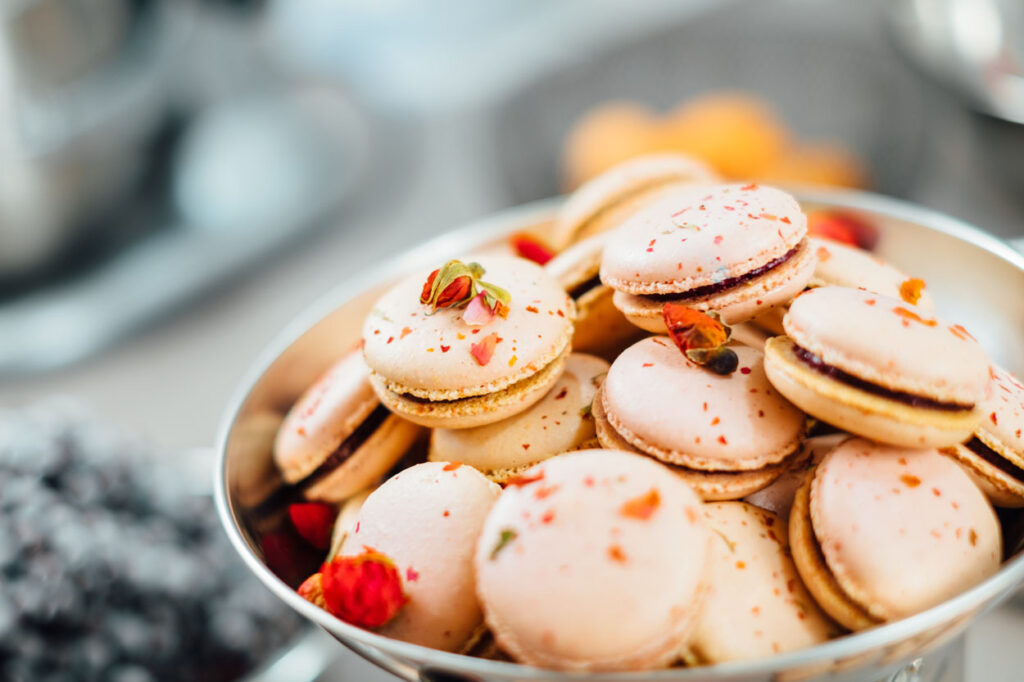
Laudurée
It wasn’t until 1930 when Ernest Laudurée (founder of Laudurée pastry shops) brought new life to this traditional classic. From then on, macarons have been one of the most popular desserts in France and have almost become an iconic symbol of the city. So even though Marie Antonette wouldn’t have eaten them, there is no doubt they feel like she would have if she lived today. So I say go on and enjoy a few macarons no matter the historical accuracy. They are too delicious to pass up and their red and green colours you can find look amazing on your Christmas table. If you want to try your hand at making them yourself there are many recipes online but be warned they are a tricky treat to make. But all the more impressive once you master the craft!
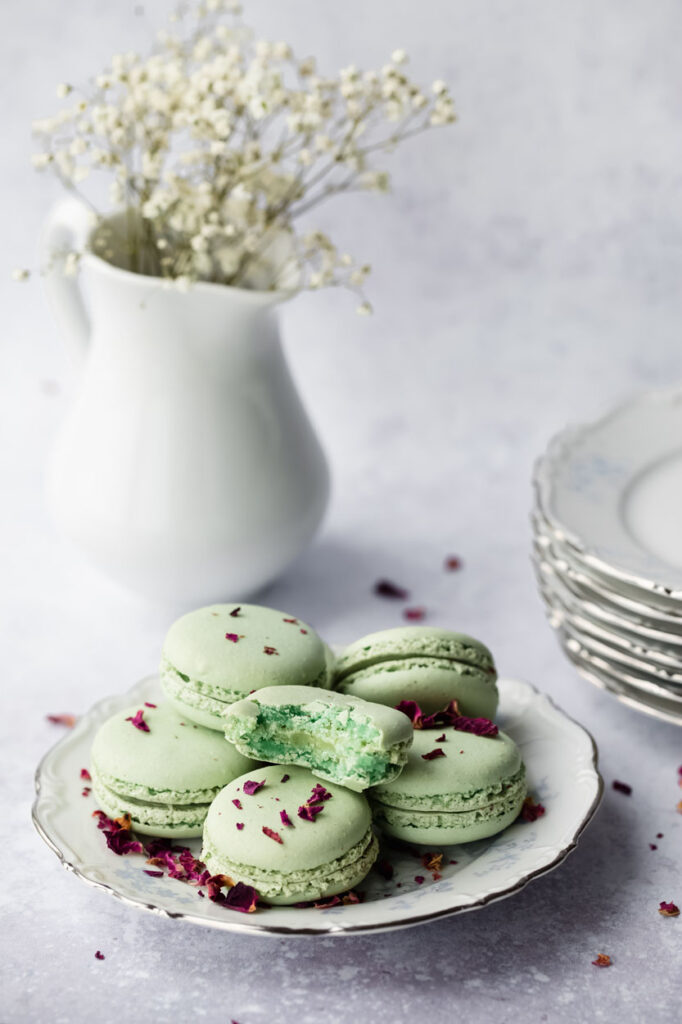
Open Gifts of New Years Day
In the 18th century, when Marie Antoinette lived in Versaille, Christmas gifts weren’t opened on December 25th like we do today. Back then, in France people didn’t exchange gifts or étrennes until January 1st. While you might not be able to hold back all month, I would try to save one or two gift to open in the new year. This tradition allows you to make the celebrations last even longer!
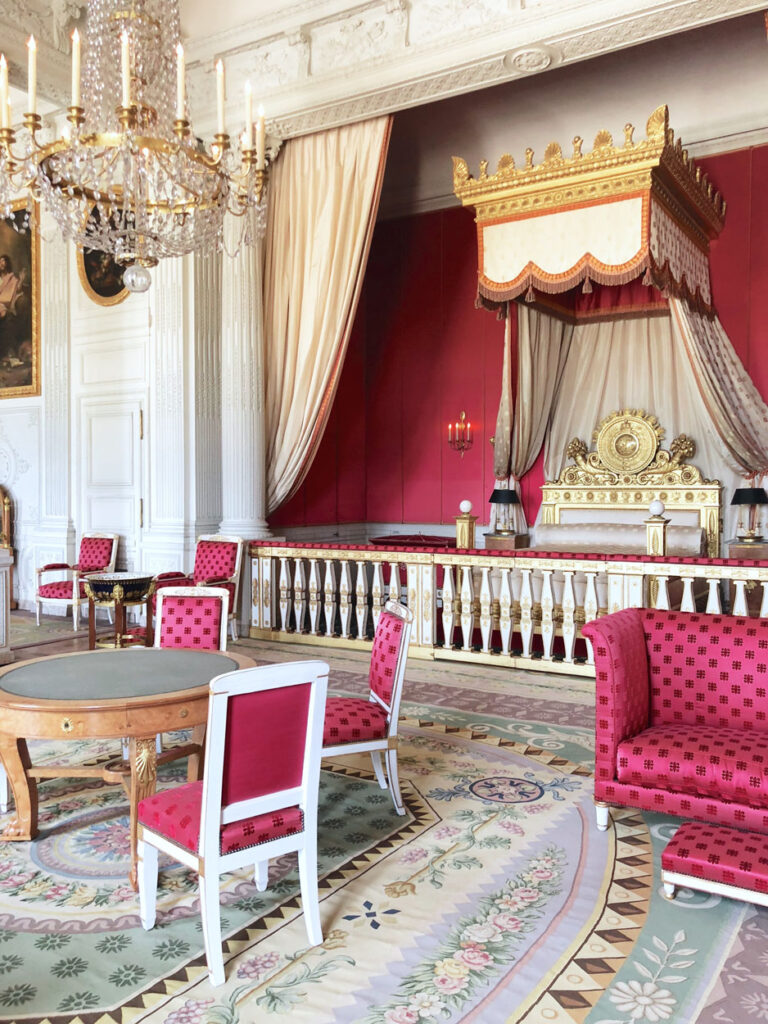
I hope you found these exciting ideas and traditions inspiring! Hopefully, you are motivated to go out and create your own Christmas Versailles at home. Let me know in the comments what fascinating holiday traditions you’ve discovered around the world.
Happy Travels, Adventurers!

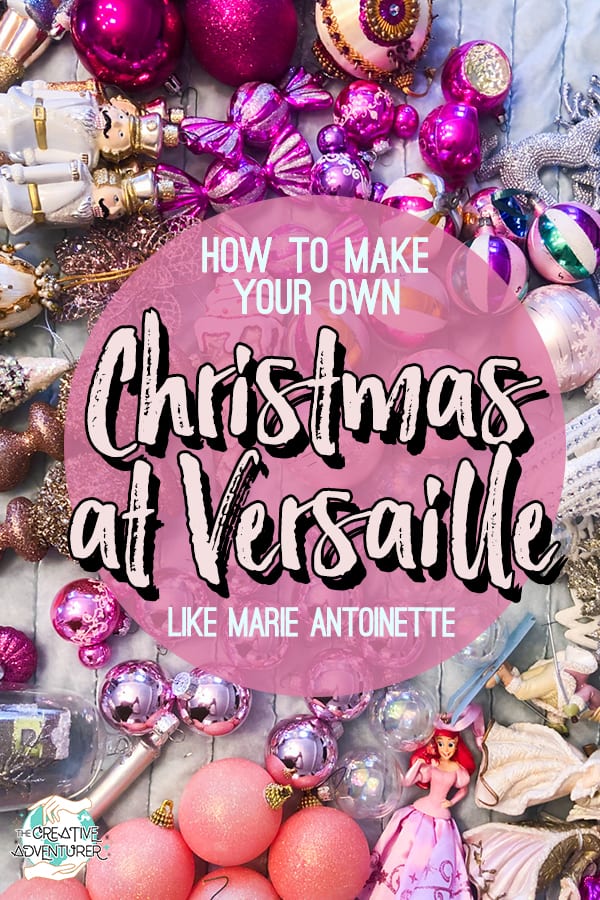
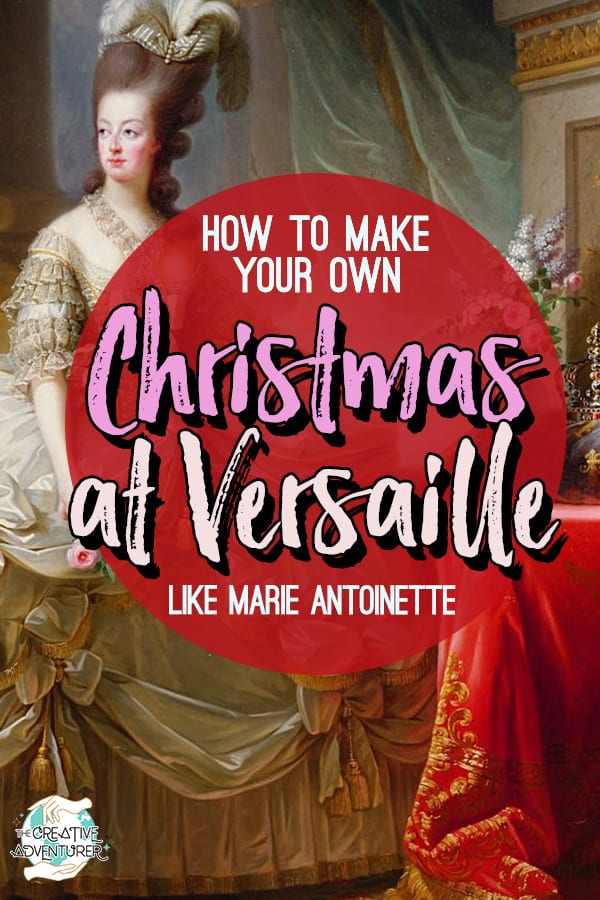
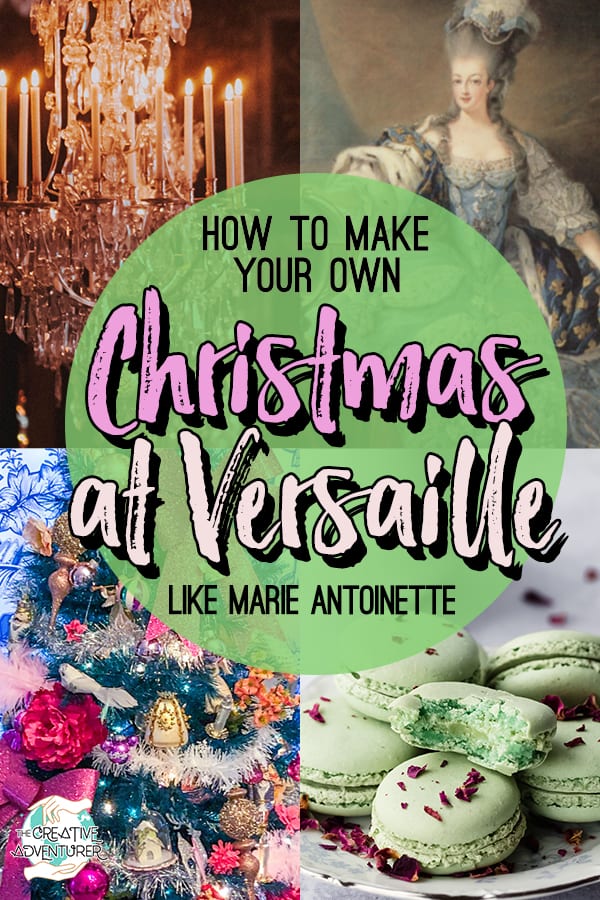


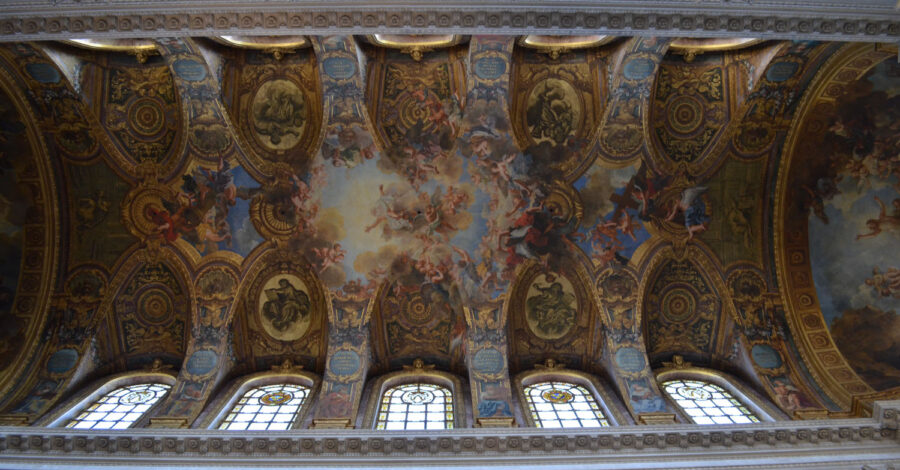
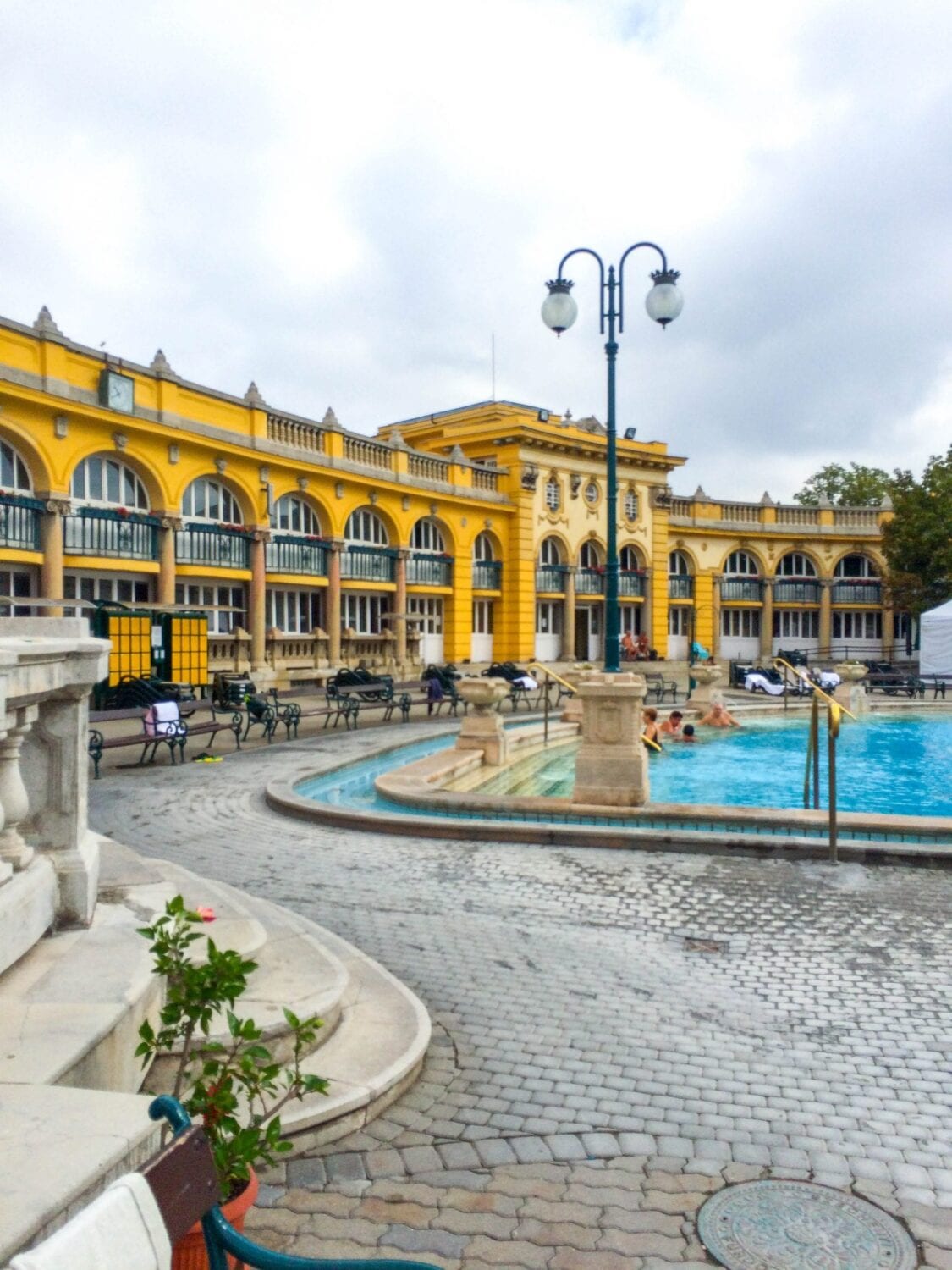
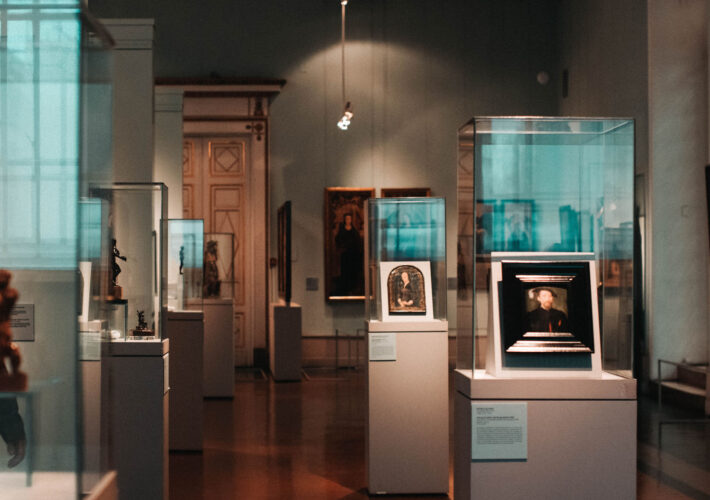
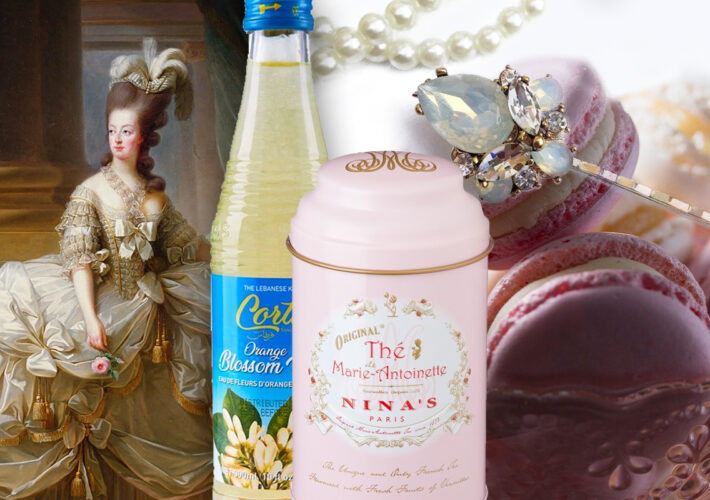

2 COMMENTS
Elena
4 years agoThere is an error in your article :it was Louis XIV who made Versailles his headquarters and the opulent palace it became but he was most certainly not married to Marie-Antoinette. Her husband was Louis XVI. I know all the King Louis are hard to keep track of but as you mentioned “King Louis” a lot without specifying which one you are referring to, it is a bit confusing. Otherwise, great article, and lot of fun. Thanks!
laura.f.whelan
4 years ago AUTHORThanks so much for taking the time to write! I will be sure to update the post with those specifics!